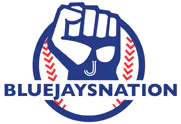Tarik Skubal vs. Bo Bichette An EPIC 13-pitch battle ... but who came out on top?
Can the Blue Jays’ contact-oriented approach play in the power-happy postseason?

Photo credit: John E. Sokolowski-Imagn Images
Oct 3, 2025, 18:00 EDTUpdated: Oct 3, 2025, 16:19 EDT
The same baseball truism is repeated each year when the calendar turns to October – power plays in the postseason.
This doesn’t bode particularly well for the Toronto Blue Jays, whose 191 home runs tied for 11th in MLB this season and ranked seventh out of 12 playoff teams. This isn’t terrible, but they had far more success scoring runs in what is often considered a more traditional, small-ball style. That is by stringing together hits, moving runners along and putting the ball in play more than any other team in the bigs.
The Blue Jays’ 78.5% contact rate led the major leagues. Their 17.7% strikeout rate was the lowest in MLB and the second lowest of any team over the last eight seasons. They led the American League with 35 sac bunts and were remarkably successful at cashing runners in those situations. The result was finishing fourth in both runs scored (798) and wRC+ (112).
Unfortunately, all those methods become less successful in the postseason. When the selection of pitchers toeing the rubber goes from a league-wide group full of innings-eaters and quad-A guys to exclusively the best arms on the best teams, it becomes understandably more difficult to stack hits or make contact at all, for that matter.
In the postseason, a higher percentage of runs are scored in one fell swoop (or swing). This is what’s called a team’s Guillen number – or the percentage of their runs that are scored on home runs. The New York Yankees led MLB by scoring 50.2% of their runs on long balls this season. This is unsurprising since they also led the majors with 274 home runs, 30 more than the second-placed Los Angeles Dodgers. Alternatively, the Blue Jays had a Guillen number of only 38.3%, ranking 23rd in runs scored via homer.
The MLB-wide Guillen number this past season was 41.1% and has generally landed between 39-41% in recent seasons. But due to the increased quality of pitching in October, it has gone up to between 47-49% during the postseason in each of the last three seasons.
Guillen numbers:
Year | Regular season | Postseason |
2022 | 39.8% | 46.8% |
2023 | 39.7% | 49% |
2024 | 40.7% | 47% |
(per Baseball Prospectus)
However, the Blue Jays’ contact-oriented lineup has performed well against top pitchers this season. Consider the way Toronto’s bats gave a gauntlet of flame throwers and aces, including Logan Webb, Carlos Rodón, Max Fried and Paul Skenes, fits during the summer months. Even though Tarik Skubal threw six scoreless innings against the Blue Jays in July, they drew three walks (tied for the second-most in Skubal’s career), forced him to throw 96 pitches – fouling off 23 – and got to the Tigers’ bullpen in the final three innings for a 6-1 win. Bo Bichette’s outrageous 13-pitch walk pushed the repeat AL Cy Young favourite over the edge in the sixth.
It seems increasingly unlikely that Bichette will be available for the ALDS. The Blue Jays missing one of their best hitters – one of the best hitters in baseball, period – would be a tremendous blow. Yet they have other hitters who can wage a similar war of attrition.
Nathan Lukes won a 14-pitch at bat against former Yankee reliever Clayton Beeter, where he saw seven 97 m.p.h. fastballs, by lashing a shoulder-height heater down the third-base line for a two-run double. The Blue Jays went on to win 8-5, one of their eight crucial wins over New York this season that helped secure the tiebreaker, AL East title and division series bye.
Davis Schneider had a 14-pitch showdown against a current Yankee, Rodón. That one ended in a pop-up, but the Blue Jays went on to score two more runs that inning and chase the all-star left-hander the next. He allowed four runs and 11 baserunners over only five innings.
Davis Schneider’s 4.59 pitches per plate appearance is first in MLB (min. 100 plate appearances). The 14-pitch showdown with Rodon Monday certainly helped.
The Blue Jays also may have more power hiding in their lineup than meets the eye. Vladimir Guerrero Jr. has been mired in one of the worst slumps of his career recently but still possesses some of the best raw power in the majors, certainly more than the 23 home runs he hit this season. Only Cal Raleigh and Giancarlo Stanton averaged more home runs per plate appearance than Daulton Varsho. If Anthony Santander can recapture even some of the form that saw him blast 44 round-trippers last season, it would be a much-welcomed development for this order.
But they can’t rely on that hidden power to rear its head in smallest-of-sample-size postseason baseball. Instead, they’ll have to keep doing what they’ve done all season, be annoying. Foul off a million pitches. Put the ball in play and hope the BABIP gods are on their side. After all, over half of the runs scored in recent postseasons aren’t of the big-fly variety.
The last five teams to win the World Series have all finished the regular season top four in regular-season home runs. But the Blue Jays can follow the lead of teams like the 2023 Arizona Diamondbacks and 2021 Houston Astros, who were both lower home run and higher contact rate teams that made the World Series.
To be one of the last two teams standing, the Blue Jays will need to rely heavily on the likes of Ernie Clement, Alejandro Kirk, Nathan Lukes and Vladimir Guerrero Jr. – all of whom have a 90th percentile strikeout rate or better – to grind out lengthy at-bats. Making a Yankees defence that ranked seventh in errors work for every out in the ALDS would be a good start.
Interestingly, the Blue Jays have consistently prioritized players with both strong contact and on-base profiles. Spencer Horwitz, Alan Roden and Will Wagner are other recent examples. These players aren’t in the organization anymore, but in the case of Horwitz and Roden, they were developed in the system for years. Wagner was identified as a trade target. The Blue Jays have shown they value these types of hitters.
In a thought experiment conducted by Paul DePodesta of “Moneyball” fame, he asked, “If a team had an on-base percentage of 1.000 – that is, every hitter got on base – how many runs would it score? An infinite number of runs, since the team would never make an out.”
Comparatively, a team with a 1.000 slugging percentage could potentially score only one run in an inning – one home run and three outs. Hence, OBP is more valuable than SLG. On-base percentage is the measure of not making outs, but is the optimized version of this idea both players who don’t make unnecessary outs by understanding the strike zone and not chasing outside of it, while also rarely striking out when they do swing.
The surest out is a strikeout. While an out being recorded is less likely when a ball is put in play at an optimal speed and angle, putting the ball in play at all immediately creates a greater chance of an out not being recorded. Therefore, theoretically, players who both walk at a good rate and don’t strikeout, serve to further gamify the ideals put forth by DePodesta. Errors aren’t included in on on-base percentage. Could targeting this archetype of hitters be an organizational philosophy in the same ilk? I don’t know. But it’s clear that the Blue Jays value contact and have taken a particular interest in players with this offensive profile.
Regardless of the organization’s wider philosophy on optimizing offence, the Blue Jays have games to win in the here and now. The biggest games that the franchise will have played in nearly a decade.
On offence, they’ll battle the Bronx Bombers’ Goliath bats like David with his sling and stone, hoping to flip the script on a postseason that has favoured heavy hitters in recent years.
Celebrate Vladdy’s big news in style with the exclusive new BlueJaysNation Vladdy merch — available only at NationGear.ca! Rep a future Hall of Famer and wear your team’s pride loud. Limited drop. Don’t miss out.
Breaking News
- Tommy Nance’s lack of option years put the Blue Jays in a tough spot
- Blue Jays: What a good season looks like for Vladimir Guerrero Jr. in 2026
- Team Canada to use Blue Jays’ home run horn at 2026 World Junior Championship
- 4 New Year’s resolutions for the Blue Jays in 2026
- Blue Jays: 3 players to trade the farm system for this offseason

